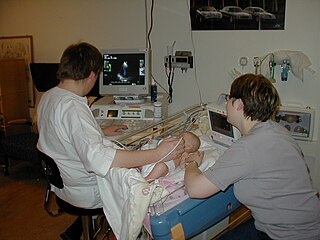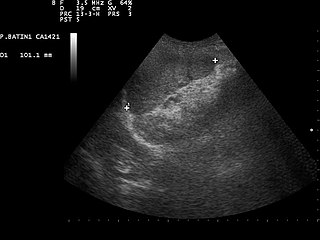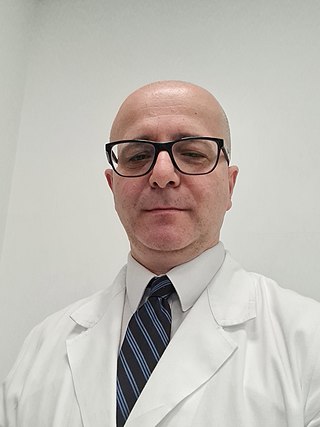Related Research Articles

Ultrasound is sound with frequencies greater than 20 kilohertz. This frequency is the approximate upper audible limit of human hearing in healthy young adults. The physical principles of acoustic waves apply to any frequency range, including ultrasound. Ultrasonic devices operate with frequencies from 20 kHz up to several gigahertz.

Medical ultrasound includes diagnostic techniques using ultrasound, as well as therapeutic applications of ultrasound. In diagnosis, it is used to create an image of internal body structures such as tendons, muscles, joints, blood vessels, and internal organs, to measure some characteristics or to generate an informative audible sound. The usage of ultrasound to produce visual images for medicine is called medical ultrasonography or simply sonography, or echography. The practice of examining pregnant women using ultrasound is called obstetric ultrasonography, and was an early development of clinical ultrasonography. The machine used is called an ultrasound machine, a sonograph or an echograph. The visual image formed using this technique is called an ultrasonogram, a sonogram or an echogram.
Medical physics deals with the application of the concepts and methods of physics to the prevention, diagnosis and treatment of human diseases with a specific goal of improving human health and well-being. Since 2008, medical physics has been included as a health profession according to International Standard Classification of Occupation of the International Labour Organization.

Medical imaging is the technique and process of imaging the interior of a body for clinical analysis and medical intervention, as well as visual representation of the function of some organs or tissues (physiology). Medical imaging seeks to reveal internal structures hidden by the skin and bones, as well as to diagnose and treat disease. Medical imaging also establishes a database of normal anatomy and physiology to make it possible to identify abnormalities. Although imaging of removed organs and tissues can be performed for medical reasons, such procedures are usually considered part of pathology instead of medical imaging.

Echocardiography, also known as cardiac ultrasound, is the use of ultrasound to examine the heart. It is a type of medical imaging, using standard ultrasound or Doppler ultrasound. The visual image formed using this technique is called an echocardiogram, a cardiac echo, or simply an echo.

Obstetric ultrasonography, or prenatal ultrasound, is the use of medical ultrasonography in pregnancy, in which sound waves are used to create real-time visual images of the developing embryo or fetus in the uterus (womb). The procedure is a standard part of prenatal care in many countries, as it can provide a variety of information about the health of the mother, the timing and progress of the pregnancy, and the health and development of the embryo or fetus.
Translational medicine develops the clinical practice applications of the basic science aspects of the biomedical sciences; that is, it translates basic science to applied science in medical practice. It is defined by the European Society for Translational Medicine as "an interdisciplinary branch of the biomedical field supported by three main pillars: benchside, bedside, and community". The goal of translational medicine is to combine disciplines, resources, expertise, and techniques within these pillars to promote enhancements in prevention, diagnosis, and therapies. Accordingly, translational medicine is a highly interdisciplinary field, the primary goal of which is to coalesce assets of various natures within the individual pillars in order to improve the global healthcare system significantly.

A sonographer is an allied healthcare professional who specializes in the use of ultrasonic imaging devices to produce diagnostic images, scans, videos or three-dimensional volumes of anatomy and diagnostic data. The requirements for clinical practice vary greatly by country. Sonography requires specialized education and skills to acquire, analyze and optimize information in the image. Due to the high levels of decisional latitude and diagnostic input, sonographers have a high degree of responsibility in the diagnostic process. Many countries require medical sonographers to have professional certification. Sonographers have core knowledge in ultrasound physics, cross-sectional anatomy, physiology, and pathology.

Focused assessment with sonography in trauma is a rapid bedside ultrasound examination performed by surgeons, emergency physicians, and paramedics as a screening test for blood around the heart or abdominal organs (hemoperitoneum) after trauma. There is also the extended FAST (eFAST) which includes some additional ultrasound views to assess for pneumothorax.

Diagnostic medical sonography (DMS), a branch of diagnostic medical imaging, is the use of imaging by medical ultrasound for medical diagnosis. DMS uses non-ionizing ultrasound to produce 2D and 3D images of the body. In Canada, the credentialing for diagnostic medical sonography is the Canadian Association of Registered Ultrasound Professionals. In the United States, the credentialing body is the American Registry for Diagnostic Medical Sonography.
Roger Cobban Sanders is an American doctor specializing in Ultrasound and Radiology. Originally from the United Kingdom, he obtained a degree in physiology at Oxford University, from the Oxford Clinical Medical School. In 1970 Sanders traveled to the United States to begin a one-year teaching position at Johns Hopkins University in Baltimore, Maryland. During this time the University was presented a bistable ultrasound system, at the time the only one in Maryland, which Sanders was asked to oversee and use. Eventually he became professor of Radiology, Urology, Obstetric, and Gynecology, as well as director of Ultrasound at the University. He helped develop the department within the University, and it has grown into one of the foremost radiology institutions in the United States, having been named the "Cream of the Crop" by Medical Imaging Magazine in April 2007.
Emergency ultrasound employing point-of-care ultrasound (POCUS) is the application of ultrasound at the point of care to make immediate patient-care decisions. It is performed by the health care professional caring for the injured or ill persons. This point-of-care use of ultrasound is often to evaluate an emergency medical condition, in settings such as an emergency department, critical care unit, ambulance, or combat zone.
The Institute of Sonology is an education and research center for electronic and computer music based at the Royal Conservatoire of The Hague in the Netherlands.
Home ultrasound is the provision of therapeutic ultrasound via the use of a portable or home ultrasound machine. This method of medical ultrasound therapy can be used for various types of pain relief and physical therapy.
Clinical point of care (POC) is the point in time when clinicians deliver healthcare products and services to patients at the time of care.

The Journal of Diagnostic Medical Sonography (JDMS) is the bimonthly, peer-reviewed medical journal of the Society of Diagnostic Medical Sonography (SDMS), and has been in publication since 1985. JDMS publishes peer-reviewed manuscripts supporting the translational use of medical ultrasound for diagnosis, intervention, and other clinical applications by a sonographer, sonologist, or other health care provider. The JDMS provides research, clinical, and educational content for all specialties, including but not limited to abdominal, women's health, pediatric, cardiovascular, musculoskeletal, and other emerging sonography practice areas. The journal's scope also includes research on instrumentation, physics, and technical advancements of ultrasonography, as well as research on sonographer education and other professional issues, including ergonomics and the prevention of work-related injuries.

Ivar Mendez is a Bolivian neurosurgeon and neuroscientist who is a professor of surgery at the University of Saskatchewan. He is known for his work in cell transplantation for Parkinson's disease and the use of remote presence robotics in neurosurgery and primary health care. In December 2022, Mendez was appointed an officer of the Order of Canada for his pioneering work in the use of remote telemedicine and robotics to revolutionize the delivery of health and patient care.

Doppler ultrasonography is medical ultrasonography that employs the Doppler effect to perform imaging of the movement of tissues and body fluids, and their relative velocity to the probe. By calculating the frequency shift of a particular sample volume, for example, flow in an artery or a jet of blood flow over a heart valve, its speed and direction can be determined and visualized.
Fracture sonography is the use of medical ultrasound to detect bone fractures. While medical ultrasound is used to visualize soft tissues like skin, organs, and blood vessels, fracture sonography is used to visualize fractures on only bone surfaces. It is useful for children aged 12 or younger because all fractures cause alterations of the bone surface, and joint fractures are uncommon at such ages. For joint fractures that are common in adult bones and cannot be visualized properly, patients older than 12 years are not eligible for ultrasound fracture diagnosis. The method is feasible for detecting fractures of the wrist, elbow, shoulder and clavicle. The advantages of fracture sonography are the avoidance of radiation exposure, faster examinations, and the ability to use standard ultrasound devices, which are more widespread. In the mentioned fields of application, ultrasound is as safe as X-ray diagnosis.

Emilio Quaia is an Italian radiologist, academic, and author. He is a professor of Radiology and the Director of the Radiology Department at the University of Padova.
References
- ↑ Hall, R. (2003),The Science of Sonology:The Semantics of the Professional, Journal of Diagnostic Medical Sonography 2003; 19; 337
- ↑ Stawicki, S. P.; Bahner, D. P. (2015-10-01). "Modern sonology and the bedside practitioner: evolution of ultrasound from curious novelty to essential clinical tool". European Journal of Trauma and Emergency Surgery. 41 (5): 457–460. doi: 10.1007/s00068-014-0464-x . ISSN 1863-9941. PMID 26037996.
- ↑ Institute of Sonology (2010) "1964 - 1986". Archived from the original on 2011-07-20. Retrieved 2011-02-06. Retrieved 2011-02-06
- ↑ University of Padova (2010) http://www.dei.unipd.it/wdyn/?IDsezione=3314&IDgruppo_pass=59&preview= Retrieved 2011-02-06.